ABSTRACT | |||||||||||||||||||||||||||||||||||
Since the beginning of the 1960s, space tourism has been investigated world-wide. NASA  Fig. 1: Holiday on the Moon - Already soon a Reality? 1. INTRODUCTION According to current reports in the media, travelling to outer space should become possible for everyone by the beginning of the next century. In April 1998, the newspaper Berlin Morgenpost reported that the international Hilton | |||||||||||||||||||||||||||||||||||
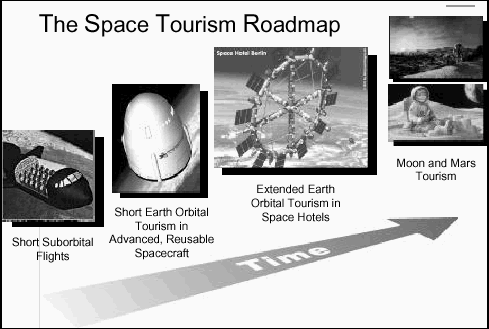 | |||||||||||||||||||||||||||||||||||
Fig. 2: The space tourism roadmap with its four sub-scenarios [ESA98, ESA99] However, the short-term realisation of this utopian project of the HiltonLife-cycle cost analyses performed in [ESA99, REICHERT97b/c/d] for the planet Mars indicate, that the transportation of humans would require ticket prices in the range of hundreds of millions of dollars, even if very favourable economic conditions in space operations are assumed. In addition, one must consider that after the successful completion of the Apollo program no transportation infrastructure is currently available that would allow humans to be transported beyond the Earth orbital. The creation of such a new infrastructure would require investments of billions of dollars. The Moon and Mars are therefore not likely to play a role in international tourism in the first half of the next century, although Mars represents one of the most promising travel destination because of its many similarities to Earth and its potential of possible former life forms. 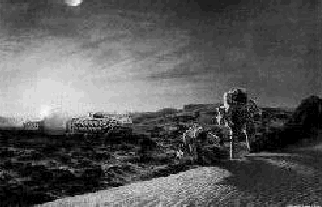 Fig. 3: The first humans explore the Martian surface Therefore future space tourism will focus for a long time on Earth orbit which can be reached more easily. Figure 2 shows the expected roadmap for space tourism for the next decades with its four sub-scenarios. It is likely, that the space tourism business is initiated by very short suborbital flights, followed by short Earth orbital tourism in advanced, reusable spacecraft which allow several orbits around Earth. Before extended stays in space hotels will become a reality in the far future, touristic trips to existing orbital facilities (e.g. the international space station) might represent an intermediate step. Already since the mid-sixties, several important analyses of Earth orbital space tourism have been carried out [EHRICKE67]. Various scenarios of transportation and accommodation of tourists in space have been analysed in the frame of industrial research in Japan, increasingly over the last 10 years [COLLINS97, MATSUMOTO97]. In the United States, NASA 2. THE INDUSTRIAL SIGNIFICANCE OF FUTURE SPACE TOURISM According to an estimate of the World Travel Tourism Council, annual global expenditures in the terrestrial tourism sector amount to about 3400 billion US dollars for the year 1995. Tourism thus globally represents one of the largest industries. If it would be possible to shift only a few percent of the world-wide terrestrial tourist expenditures to a future space tourism market, this could double the civil space budgets to 60 billion dollars. This would create up to half a million new jobs also in the high technology space industry, if it is assumed that a sales volume of $50000 to $250000 creates one job. If a space tourism business can be established in the future, the scientific and operational know-how - globally gained after decades of research and experience in manned space flight (e.g. by astronaut training centers or institutions of aerospace medicine) - could be applied to the space flight preparation and medical supervision of future space tourists. Furthermore, touristic spaceflights could be planned, controlled and monitored by existing space operation centers in Europe, the USA or Russia. As soon as a space tourism market is established, large commercially oriented industrial conglomerates will cooperate in strategic alliances to operate and expand the space tourism business comparable to the terrestrial tourism and telecommunications industries. The main motivation for an industrial investment in the space tourism sector will be the potential of very high achievable profits, which can be expected due to multi-billion dollar market potential. 3. THE MARKET FOR SPACE TOURISM As soon as the "space ticket" can be purchased for some $10000 - in the best of all cases a ticket price comparable to that of a transatlantic flight with the Concorde - one can expect that a global space tourism market will be established. This has been confirmed by first national and international polls and market analyses (e.g. in the US, Japan, Europe) which indicate that a remarkable segment of clients would be already willing to make considerable financial commitments for short trips into space. For example, 4.3% of all Germans are willing to pay several $10000 - which is roughly comparable to an annual income - for a space trip [ABITZSCH97]. This could be a ticket price which might be achievable with future generations of spacecraft, and it is comparable to the cost of a vacation on a cruise ship which already attracts a steady clientele. Figure 4 shows the expected number of passengers for a space trip as a function of the ticket costs according to international polls performed in the US, Japan, and Europe. With current costs of several ten million dollars to transport a human into space, space tourism is not affordable and finds no acceptance in the public. However, with declining space travel ticket prices the situation will change. Once a ticket price of $ 1000 is obtainable, a passenger volume of about 20 million is expected, and even with a ticket price of $ 50000 a passenger rate of 1 million per year can be expected. [ABITZSCH97]. Nevertheless, the above mentioned polls have to be critically assessed with respect to their accuracy and credibility. Therefore, more detailed and representative polls and market research in this area have to be carried out. 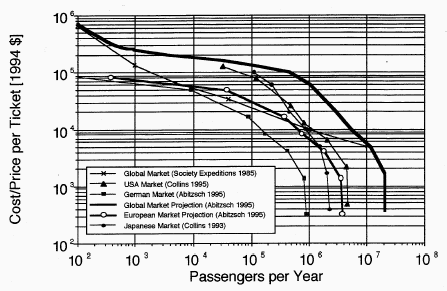 Fig. 4: Expected passengers as a function of the cost/price per ticket [ABITZSCH97] Generally, any average person in good health and with appropriate preparation is able to go on a space trip. NASA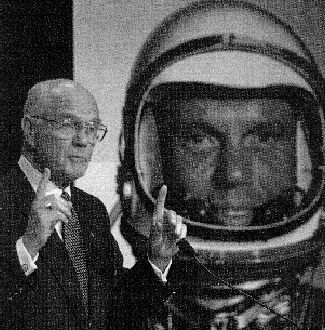 Fig. 5: A space trip at the age of 77 years: Ex-astronaut and US-Senator John Glenn [NEWSWEEK] 4. FUTURE MANNED SPACE TRANSPORTATION SYSTEM The fact that tourist space travel has not been established yet is mostly due to the high costs of manned space travel. The transportation of a passenger into orbit, for example with the Russian rocket launcher Soyuz still costs several $10 million. Therefore, alternative and less expensive space transportation system concepts have to be identified. Already in 1979, a manned Space Shuttle was proposed in [DURST79], with a cabin module designed to offer a seat capacity for 74 passengers (fig. 6). The costs for this design were calculated in 1997 to be $3.6 million per passenger, assuming a launch rate of 12 flights per year [KOELLE97].  Fig. 6: A modified Space Shuttle with a seat capacity of 74 Passengers [DURST79] A further reduction of the costs is only expected by the development of advanced, reusable single-staged spacecraft. An example of such a spacecraft is the Japanese design for the single staged Kankoh-Maru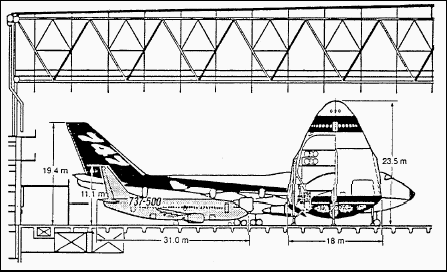 Fig. 7: The Japanese Kankoh-Maru The launch costs for this design are estimated in [KOELLE97] to be $300000 per passenger (assuming 10 launches per year) and and in [ESA98] to be about $50000 to $100000 (optimistically assuming 1 launch per day). The illustration shows the Japanese single staged launcher in comparison to a BoeingA further considerable cost reduction - ticket prices ranging from $10000 to $100000 - can therefore be only expected by the development of future generations of launchers, which have extremely high launch rates, are fully reusable and are operated with a minimum maintenance effort, comparable to today's aircraft fleets in the commercial airline business. The X-33 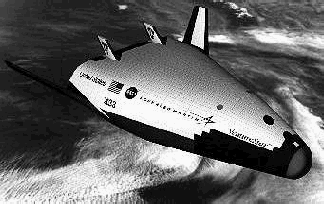 Another project aims at the same objective: the proposed Ascender 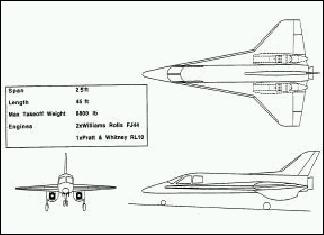 Fig. 9: The suborbital Ascender 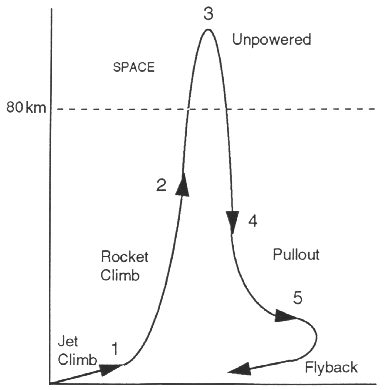 Fig. 10: A typical ascent/descent trajectory of the Ascender This might significantly increase the cost per flight and indicates that a costly development program has to be initiated to modify the RL10 engine according to the requirements of the AscenderFor this reason a first rough return on investment analysis has been carried out for the suborbital scenario in [ESA98, ESA99]. Space tourism is expected to be carried out by commercial companies which expect a profit from their business. Furthermore, in general, initial investments for the development and production have to be refinanced. Figure 11 shows the profit as a function of the operational year including and excluding financing costs, assuming a fare per passenger of $50000. If the financing costs are neglected, a first profit can be achieved in the 9th operational year which increases to about $36.6 billion in the 30th operational year. Considering financing costs, the date of the first profit shiftes to the 11th year and increases to about $34 billion in the 30th operational year. This decreased profit is caused by financing costs, which sum up to about $2.5 billion within the 30 year life cycle. The date of the first profit could be even shifted to earlier years, if the repayment of the development and production costs is spread over a longer period. Because of the relatively early return of i nvestment and the high achievable profits, the suborbital flights scenario generally looks very promising from an economic standpoint. This is also confirmed by the fact, that international polls ind icate, that the assumed ticket price of $50000 could lead to more than one million passengers per year [ABITZSCH97]. Due to the fact, that the fleet of 10 spaceplanes is only capable of transporting 43800 passengers per year, a further extension of the suborbital flights business seems very likely with decreasing ticket costs. However, it should kept in mind that the achieved profit mainly depends on low operation costs per flight (currently not state of the art) and the ability to realise the Ascender 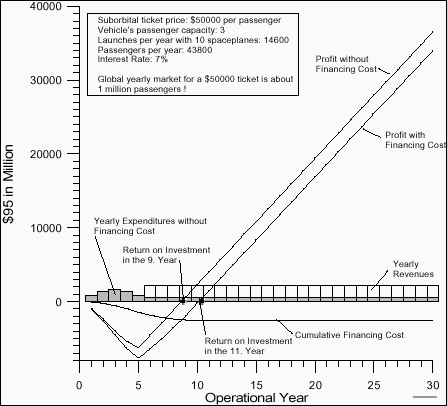 Fig. 11: Return on investment analysis for the suborbital flights scenario [ESA98] A completely different design approach is implemented in the concept of the single stage ALLTRA-M1 rocket (fig. 12) of the German FAR research group, which could also represent a promising X-prize candidate [FAR99]. A capsule, which can accommodate up to 3 crew members is mounted on top of the rocket, which is able to reach an altitude of at least 100 kilometres during a vertical ascent. The ALLTRA-M1 rocket has a total mass of only about 10 tons and has almost the dimensions of a garage. The rocket is equipped with a hybrid propulsion system, in which liquid oxygen (in the central tank) is burned up with ordinary solid plastics in the lateral boosters. The hybrid propulsion system represents an interesting propulsion alternative between the classical solid and liquid/liquid propulsion systems. Its simple design, generous production tolerances and environmentally friendly and inexpensive fuels, possibly produced from recycled materials, make them a good candidate for low-cost high power propulsion systems. Thus a complete refuelling of the ALLTRA-M1 rocket costs only about $5000 and a 2-staged rocket concept could even reach a stable orbit around Earth. However, the overall economy, the atmospheric re-entry with acceptable G-loads, the soft landing and the general reusability still have to be demonstrated for the ALLTRA-M1 rocket in further studies. 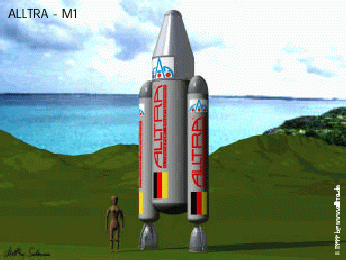 Fig. 12: The ALLTRA-M1 hybrid rocket [FAR99] 5. TOURISM IN SPACE HOTELS In order to provide longer touristic stays in Earth orbit, concepts for space hotels have been investigated world-wide. In Japan, several designs for large-scale space hotels were analysed in the context of industrial studies like the Shimizu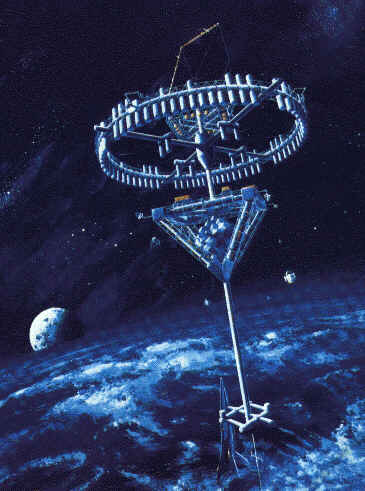 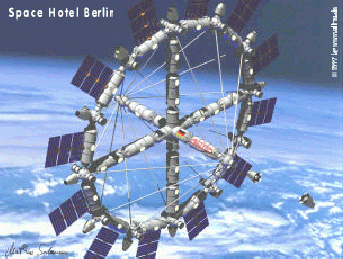 Fig. 14: The rotatingSpace Hotel Berlin concept in Earth Orbit [REICHERT98, ESA99] Rotating the circular structure with different velocities, creates a wide variety of artificial gravity levels. With regard to mass and costs, the Space Hotel Berlin is about comparable to the International Space StationFigure 15 shows the major subsystems of one basic element, of which the Space Hotel Berlin concepts consists during the first build-up phase. The central subsystem is a cylindrical "apartment"-module with a large panoramic window which is capable to accommodate about 4 tourists. Connected to the module is a solar array which provides in combination with a rechargeable battery pack sufficient electrical energy for the flight phases when the space hotel enters into the Earth's shadow for about 40 minutes. Furthermore, a multifunctional connecting node, which can be entered by humans, is docked at the apartment module. This node provides five further docking ports which can be used, if needed in subsequent build-up phases, to connect additional apartment modules. For safety reasons each node has its own rescue capsule, which can be used in emergencies for the immediate return of the tourists back to Earth. With respect to the main apartment axis, the connecting node is 30o aligned, which causes the circular structure of the Space Hotel Berlin with a capacity of about 50 tourists. 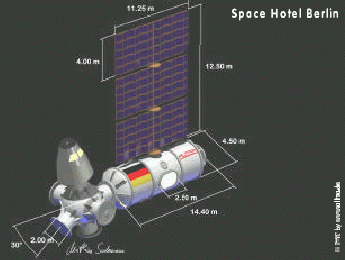 Fig. 15: The basic element of the Space Hotel Berlin concept [REICHERT98, ESA98] Figure 16 shows an artist view of the Space Hotel Europe concept, which is derived from the circular structure of theSpace Hotel Berlin to simplify the rendezvous/docking manoeuvres and to improve the living conditions. 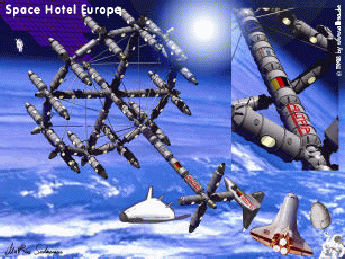 Fig. 16: TheSpace Hotel Europe concept [ESA99] 6. THE FASCINATION OF SPACE TRAVEL The fact, that a significant portion of the public is willing to spend a lot of money on space trips proofs that these are regarded as very promising and fascinating. The confrontation with the high technology of space missions, the heroic myth of astronauts, and the possibility of orbiting planet Earth in just a little more than 80 minutes with a speed of about 30000 kilometres per hour (compared to the 80 days needed a hundred years ago) will represent for each tourist an unforgettable adventure and event. Furthermore, for the first time in his life, the tourist in a space hotel will experience an entirely different environment. Depending on the rotational velocity of the Space Hotel Berlin various levels of artificial gravity can be obtained, ranging from customary terrestrial gravity (1G) to Mars gravity (1/3 G) and even Lunar gravity (1/6 G), i.e. a human being will weigh only one sixth of his or her earthly weight. In the central node of the Space Hotel Berlin there will be nearly zero gravity. Here the tourist can experience weightlessness. How does one behave if one can not get from A to B in a normal way and "above" or "below" are without meaning. Many of the questions that astronauts were asked - how they manage eating, sleeping, and personal hygiene - can be explored by tourists themselves. The zerogravity area also offers fascinating opportunities for entirely new sorts of entertainment, games and sports. For example a ball game in zero-gravity and three-dimensional space. Or one can imagine a swimming pool. The water would not be in a basin, but would float as wobbly water bubbles in space, some of which are several meters in diameter, and one can swim and dive through them. One can imagine that some tourists may want to use the zero-gravity zones for future medical therapies: This could represent a first step towards a future space hospital. Furthermore, the Coriolis force, which only appears within rotating systems, will baffle the tourist, since it will push him, like a magic force, into a certain direction, depending on his direction of movement. Probably, the predominant part of the vacation will be spent with the breathtaking view each tourist will have from the panoramic window of each apartment onto the blue home planet from a distance of 400 kilometres. Even if initially concentrating on his home city and country, soon the tourist will discover earth with its thin and precious atmosphere and a wide variety of picturesque structures on its surface as a totality without national borders. On the other hand, the view of the infinite expanse of outer space will dramatically symbolise that we owe our human existence, history and future a singular, beautiful, tiny "grain of sand" which we call Earth. After returning to Earth, the consciousness of many tourists may have changed; it will be expanded and globalised with many potentially positive social consequences, which could help, for example, to lower the dangers for environmental pollution, local conflicts, and war. Once space tourism is affordable to the broad public, space activities - especially manned space programs - will develop and increase in a way that is hardly imaginable today. A wide variety of space station concepts have been investigated for decades (fig. 17) and first concepts for gigantic, circular cities in orbit are available. Perhaps many humans increasingly will harbour the wish to visit the more remote planetary worlds of Mars and of the Earth's Moon some day, according to the Russian space pioneer Ziolkowksy who proclaimed around the year 1900: "Earth is the cradle of humanity, but one cannot always remain in the cradle."  7. REFERENCES
| |||||||||||||||||||||||||||||||||||
.gif)
.gif)


0 Responses So Far:
Post a Comment